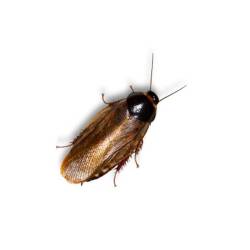 Surinam Cockroach: A Plant Pest
Surinam Cockroach: A Plant Pest
The Surinam cockroach or greenhouse cockroach (Pycnoscelus surinamensis) is a species of burrowing cockroach that can cause damage to plants, especially in tropical and subtropical regions. It is also a common pest in heated greenhouses, where it can hide in the soil and feed on the softer parts of plants at night. In this article, we will describe the appearance, behavior, diet, reproduction, and prevention tips of this cockroach.
Appearance
The Surinam cockroach is about 18–25 mm (0.71–0.98 in) long, with a dark brown to black body and shiny brown wings. The front edge of the head shield has a pale white band. The males have longer wings than the females, but neither sex can fly well. The nymphs are translucent white with orange-brown mandibles and spines when they hatch, but they become glossy brown after a few hours.
Behavior
The Surinam cockroach is a burrowing insect that prefers moist soil, humus, compost, lawn thatch, or other organic debris. It can also be found under rocks, rotten branches, trash, and woodpiles. It is active at night and avoids light. It can survive in a wide range of temperatures, but it prefers warm and humid conditions. It can spread to new areas by hitching a ride in the soil of tropical plants that are shipped to greenhouses and nurseries.
Diet
The Surinam cockroach feeds on various types of plants, both indoors and outdoors. It can gnaw on the leaves, stems, roots, flowers, fruits, and seeds of ornamental plants, vegetables, fruits, herbs, and grasses. It can also feed on fungi and decaying organic matter. It can cause significant damage to plants by reducing their growth, vigor, and yield.
Reproduction
The Surinam cockroach reproduces through parthenogenesis, which means that the females can produce offspring without mating with males. In fact, there are no male Surinam cockroaches in North America. The females produce egg cases that contain about 24 eggs each. They carry the egg cases inside their bodies until they are ready to hatch. The nymphs take about six months to reach adulthood and can live for up to two years.
Prevention Tips
To prevent or control Surinam cockroach infestations, you can follow these tips:
- Inspect the soil of any plants that you buy or receive as gifts for signs of cockroaches or their eggs.
- Avoid overwatering your plants and make sure they have good drainage.
- Remove any leaf piles, trash, compost, woodpiles, or other organic debris that can provide shelter and food for cockroaches.
- Seal any cracks or gaps in your foundation, walls, doors, windows, or vents that can allow cockroaches to enter your home.
- Use sticky traps or baits to monitor and reduce the population of cockroaches.
- Contact a professional pest control service if you have a severe or persistent infestation.
Pest control is important to protect your plants and your health from Surinam cockroaches. By using natural pest control methods or hiring a pest control expert, you can prevent these insects from ruining your garden or greenhouse.
 Surinam Cockroach: A Plant Pest
Surinam Cockroach: A Plant Pest